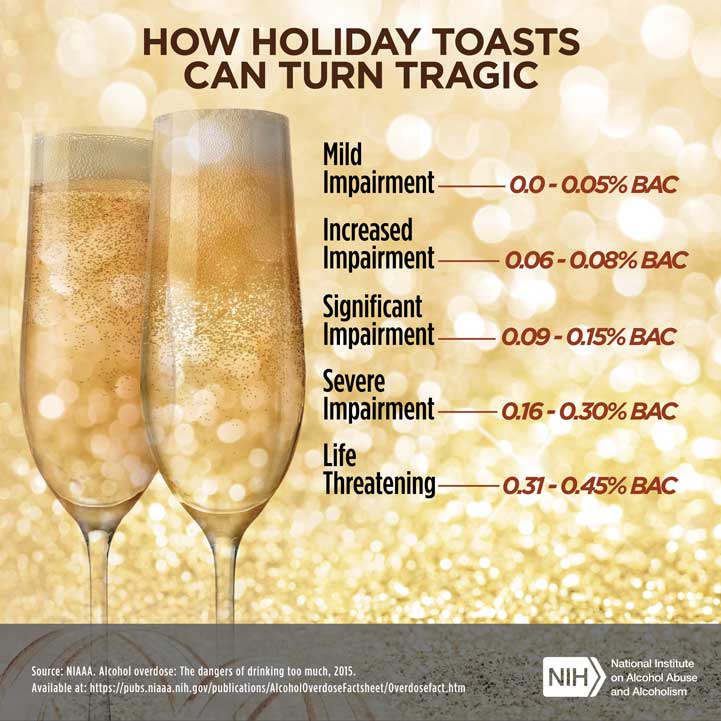By Walter Sorochan Emeritus Professor San Diego State University
Posted December 24, 2018; updated November 16, 2021. Disclaimer The information presented here is for informative and educational purposes only and is not intended as curative or prescriptive advice. The statements of this web-site have not been evaluated by the United States Food and Drug Administration (FDA). Nothing stated here should be considered as medical advice for dealing with a given problem, or to diagnose / treat / prevent / cure any disease.
Alcohol's Effects on the Body
Drinking too much – on a single occasion or over time – can take a serious toll on your health. Here’s how alcohol can affect your body:
Prevention:
The research evidence indicates that the more alcohol a person drinks—particularly the more alcohol a person drinks regularly over time—the higher his or her risk of developing an alcohol-associated cancer. The chart below right illustrates this.
 New Year, Old Myths, New Fatalities: Alcohol-Related Traffic Deaths Jump During
Christmas and New Year’s Some holiday predictions are, tragically, very
predictable. For example, more people are likely to die in alcohol-related
traffic crashes during the holidays than at other times of the year. Statistics
show that during Christmas and New Year’s, two to three times more people die in
alcohol-related crashes than during comparable periods the rest of the year. And
40 percent of traffic fatalities during these holidays involve a driver who is
alcohol-impaired, compared to 28 percent for the rest of December.
New Year, Old Myths, New Fatalities: Alcohol-Related Traffic Deaths Jump During
Christmas and New Year’s Some holiday predictions are, tragically, very
predictable. For example, more people are likely to die in alcohol-related
traffic crashes during the holidays than at other times of the year. Statistics
show that during Christmas and New Year’s, two to three times more people die in
alcohol-related crashes than during comparable periods the rest of the year. And
40 percent of traffic fatalities during these holidays involve a driver who is
alcohol-impaired, compared to 28 percent for the rest of December.
Myths Persist: Even though many of us are aware of these troubling statistics, myths about drinking and driving persist—myths that, for some, can prove fatal. Scientific studies supported by the National Institute on Alcohol Abuse and Alcoholism provide important information that challenges these widespread, yet incorrect, beliefs about how quickly alcohol affects the body and how long these effects can last. Alcohol’s Effects Begin Quickly.
Holiday revelers may not recognize that critical driving-related skills and decision making abilities are diminished long before they show physical signs of intoxication. Initially, alcohol acts as a stimulant, and people who drink may temporarily feel upbeat and excited. But they shouldn’t be fooled. Alcohol soon affects inhibitions and judgment, leading to reckless decisions behind the wheel.
As more alcohol is consumed, reaction time suffers and behavior becomes poorly controlled and sometimes aggressive—further compromising driving abilities. Continued drinking can lead to the slurred speech and loss of balance that we typically associate with being drunk. At higher levels, alcohol acts as a depressant, which causes the drinker to become sleepy and sometimes pass out. [National Highway Traffic Safety Administration, Traffic Safety Facts, December 2007].
Even When Drinking Stops—Alcohol’s Effects Do Not. During a night of drinking, it’s also easy to misjudge alcohol’s lasting effects. Many revelers believe that they can drive safely once they stop drinking and have a cup of coffee. The truth is that alcohol continues to affect the brain and body long after the last drink has been downed. Even after someone stops drinking, alcohol in the stomach and intestine continues to enter the bloodstream, impairing judgment and coordination for hours.
Driving home late at night is especially hazardous because the depressant action of alcohol magnifies a person’s natural drowsiness. Driving abilities may even be impaired the next day, when any alcohol remaining in the system—or the headache and disorientation associated with hangovers—contributes to feelings of sluggishness, even though the person no longer feels drunk.
Before You Celebrate—Plan Ahead: Of course, we don’t intend to harm anyone when we get behind the wheel during the holiday season. Yet traffic fatalities persist and myths about drinking live on—even though scientific studies have documented how alcohol affects the brain and body. Because individuals are so different, it is difficult to give specific advice about drinking. But certain facts are clear—there’s no way to speed up the brain’s recovery from alcohol and no way to make good decisions when you are drinking too much, too fast. So this holiday season, do not underestimate the effects of alcohol. Don’t believe you can beat them. Here are some tips to keep in mind if you choose to drink:
Have a safe holiday season and year!
References:
NIH, "Fact Sheet- The truth about holiday spirits," Natonal Institute on Alcohol Abuse and Alcoholism. NIH: Alcohol abuse